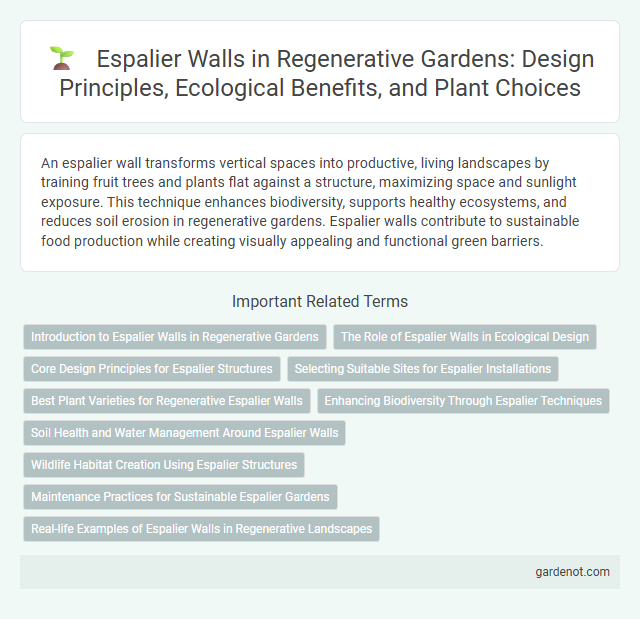An espalier wall transforms vertical spaces into productive, living landscapes by training fruit trees and plants flat against a structure, maximizing space and sunlight exposure. This technique enhances biodiversity, supports healthy ecosystems, and reduces soil erosion in regenerative gardens. Espalier walls contribute to sustainable food production while creating visually appealing and functional green barriers.
Introduction to Espalier Walls in Regenerative Gardens
Espalier walls in regenerative gardens create living structures by training plants to grow flat against vertical surfaces, maximizing space and promoting biodiversity. These walls enhance microclimates, improve air quality, and support soil health through root optimization and nutrient cycling. Integrating espalier techniques fosters sustainable food production while conserving natural resources in urban and small-scale garden settings.
The Role of Espalier Walls in Ecological Design
Espalier walls optimize space by training fruit trees and plants against vertical surfaces, creating living barriers that enhance biodiversity and microclimates in regenerative gardens. These structures contribute to ecological design by improving air quality, supporting pollinators, and reducing soil erosion through root stabilization. Integrating espalier walls promotes sustainable urban agriculture and energy efficiency by providing natural insulation and windbreaks.
Core Design Principles for Espalier Structures
Espalier wall design centers on maximizing sunlight exposure and air circulation by training plants flat against vertical surfaces, optimizing space in regenerative gardens. Key principles include selecting suitable tree species like apple or pear, ensuring structural support with sturdy frameworks, and pruning meticulously to maintain desired shapes. Incorporating these elements enhances photosynthesis efficiency and soil health while promoting sustainable growth.
Selecting Suitable Sites for Espalier Installations
Choosing an optimal site for espalier wall installations requires assessing sunlight exposure, as these structures thrive in locations receiving at least six hours of direct sunlight daily. Soil quality and drainage are critical factors, with well-drained, fertile soil promoting healthy root development and preventing waterlogging. Proximity to a sturdy, south-facing wall enhances microclimate benefits, offering warmth and protection essential for successful espalier growth.
Best Plant Varieties for Regenerative Espalier Walls
Apple (Malus domestica) and pear (Pyrus communis) varieties are ideal for regenerative espalier walls due to their adaptability and high fruit yield. Quince (Cydonia oblonga) and fig (Ficus carica) also thrive with minimal maintenance while supporting local biodiversity. Incorporating native species like serviceberry (Amelanchier) can enhance soil health and attract beneficial pollinators to the regenerative garden ecosystem.
Enhancing Biodiversity Through Espalier Techniques
Espalier wall techniques enhance biodiversity by creating structured habitats for diverse pollinators and beneficial insects, promoting a balanced ecosystem. Trained branches of fruit trees and native plants maximize vertical space, increasing species variety and supporting local wildlife. This method improves air circulation and soil health, fostering resilient plant communities in regenerative gardens.
Soil Health and Water Management Around Espalier Walls
Espalier walls improve soil health by promoting deep root growth and minimizing soil compaction through strategic pruning and training techniques. Enhanced water management occurs as the vertical structure reduces surface runoff, allowing for better water infiltration and retention in the soil surrounding the root zone. This optimized moisture availability supports nutrient uptake, fostering a resilient and regenerative garden ecosystem.
Wildlife Habitat Creation Using Espalier Structures
Espalier walls provide a unique vertical habitat that supports diverse wildlife species by offering resting and nesting sites for birds, insects, and small mammals in regenerative gardens. These structures enhance biodiversity by creating microhabitats through dense foliage and fruit-bearing branches, attracting pollinators and beneficial insects essential for ecosystem health. Espaliered plants also reduce habitat fragmentation, connecting wildlife corridors and fostering natural pest control within sustainable garden systems.
Maintenance Practices for Sustainable Espalier Gardens
Regular pruning and training are essential maintenance practices for sustainable espalier gardens, ensuring healthy growth and optimal fruit production. Mulching around the base conserves soil moisture and suppresses weeds, supporting plant health while reducing water use. Monitoring for pests and diseases early facilitates organic management, maintaining the garden's regenerative balance and long-term vitality.
Real-life Examples of Espalier Walls in Regenerative Landscapes
Espalier walls transform vertical spaces into productive, regenerative garden features by training fruit trees such as apples or pears against flat walls, optimizing sunlight exposure and reducing soil erosion. In permaculture sites like the BriarPatch Cooperative in Oregon, espalier walls create microclimates that enhance biodiversity and increase yield from limited suburban spaces. These living walls also improve carbon sequestration and support beneficial insects, contributing to resilient, sustainable food systems.
Espalier wall Infographic

 gardenot.com
gardenot.com